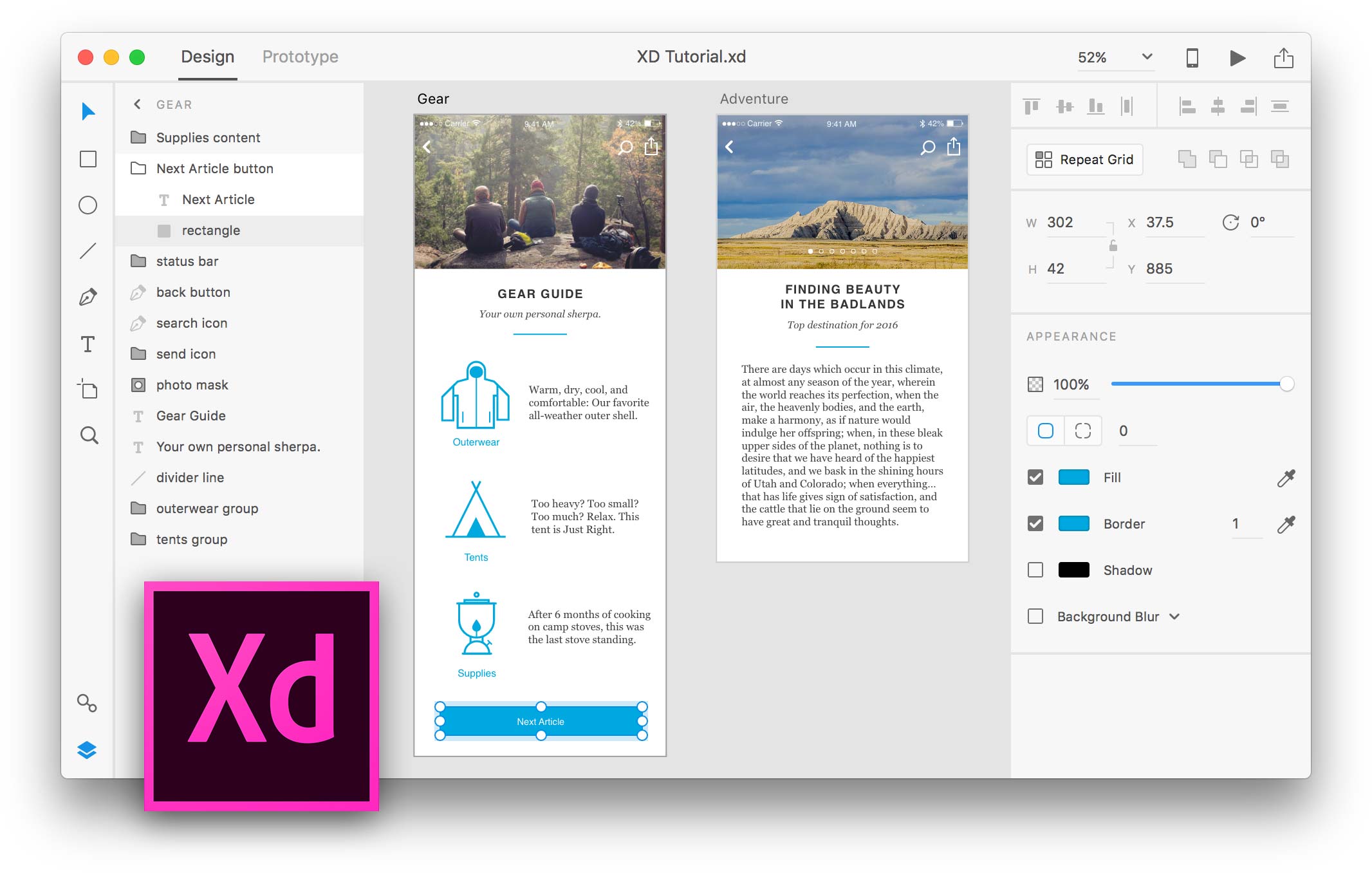At Adobe MAX 2016, Adobe said “you really have everything you need to be successful doing production work inside of XD”.
I like designing with Sketch, and Adobe Experience Design (XD) is clearly inspired by Sketch (to put it mildly). I’ve started learning XD and it does show a lot of potential. It’s still in beta, so can you really do production work with it? That depends on your needs. To help you decide, I’ve compiled a list of its limitations.
Disclosure: If you make a purchase using my links to Adobe’s website, I may earn a commission (which helps support me).

Current Limitations of Adobe Experience Design (XD)
Based on the most current Mac beta version 0.6.12.17, released in Jan 2017.
- There are no text or graphic styles.
- There are no guides or web grids. To design on a 12-column grid (such as Bootstrap) I have to draw transparent boxes to use in place of guides (which I hide and show as needed).
- There is no JPEG export.
- PNG export has no options, so you can’t choose between PNG-8 or PNG-24. You can’t decide whether you want transparency or not (they are always transparent).
- You can’t create radial gradients in XD (only linear gradients). You can copy and paste a radial gradient from Adobe Illustrator and it remains a radial gradient in XD. You can even change the colors, but you can’t change the size or position the radial gradient.
There’s only basic prototyping:
- No fixed headers or footers.
- No modal pop-ups.
- No scrollable areas. (The whole page scrolls.)
- No conditional logic or complex animations that are possible in apps such as Facebook’s free prototyping tool Origami Studio.
- You can’t convert point type (a single line) to area type (multiple lines). NOTE: Point type is a single line of type made via a click. Area type is multi-line text made via a drag.
- You can scale point type (a single line), but you can’t scale area type (multiple lines). With area type, the text frame changes width/height but the type inside remains the same size.
You can’t add drop shadows to groups:
- That means masked photos can’t have shadows because they are a group.
- If you copy and paste a logo from Adobe Illustrator it comes in as a group. You can’t add a shadow unless you ungroup and pathfinder merge it.
Type styling is basic and buggy:
- There’s no space above and below paragraphs.
- All text in a box must have the same line height. Like Sketch, a lot of text formatting is applied to everything in a box. Instead of putting headings, paragraphs, etc. all in one box, it’s best to make them separate text boxes. This is disappointing, because it’s one of the things I don’t like about Sketch.
- Buggy: Creating new text or copying/pasting sometimes lost the text styling. With no way to create styles (or copy/paste text styling) I had to manually format text over and over again.
The file format of imported graphics inconsistently affect their initial size in an XD layout:
- JPEG files import scaled down, as though they are 2x (so they appear smaller).
- Other file formats (such as PNG) don’t get scaled down (so they appear larger).
This is a weird inconsistency and to make matters worse, there’s no way to see the current resolution or see the percentage of scaling. That means there’s no reliably accurate way to know the quality of an image other than trusting your visual judgment.
- You can’t darken or lighten a photo as an effect (as you can in Sketch or Adobe Photoshop). In XD you could create a transparent rectangle over top, but then you have two objects to move/resize.
- Compared to Sketch, symbols are basic. There are no content overrides and no flexible resizing options like those found in Sketch (which are extremely useful).
- SVG files do not have a width and height coded into them. This can lead to display issues in Microsoft Edge or Internet Explorer. Adobe Illustrator at least has a preference (uncheck the Responsive option), but for SVG files exported from XD you’ll need to manually code the width and height.
You can’t have different JPEG quality settings for 1x and 2x. While Sketch can’t do this either (I really wish it could), Photoshop’s Generate Image Assets feature (called Adobe Generator) can do this.
If you didn’t know this already, 2x JPEGs should be more highly compressed than 1x (otherwise they are a larger filesize than necessary).
- You can’t choose to export only 1x or 2x web graphics, you must always export both sizes. (Sometimes I don’t need 1x.)
- You can’t hide the inspector on the right (to free up screen space).
Am I Mistaken?
If I’m wrong about anything of the points above, please let me know. I did my best to research each point before including it, but XD is a new app so there could be something I missed.
Is XD Ready for You?
XD is clearly not ready for production work for everyone, but it might be good enough for some. Adobe is releasing new features quickly, and I know some of the things listed above are planned for future versions. Adobe has also previewed some really cool looking new features, and they have done a lot of nice things with XD so far. I wanted this article to give you a better idea of whether XD is right for you as it stands today. If it’s not, I do think it will continue to improve and will likely be ready in the future. I think it’s more a matter of when, not if. Check back later for updates as it develops!
Want to try out Adobe Experience Design for yourself? Download XD now.